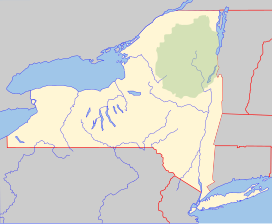Iroquois Peak




Iroquois Peak is a mountain in the MacIntyre Range of the Adirondacks in the U.S. state of New York. It is the eighth-highest peak in New York, with an elevation of 4,840 feet (1,480 m), and one of the 46 High Peaks in Adirondack Park. It is located in the town of Newcomb in Essex County. Although the mountain does not have an officially maintained trail, a well-maintained herd path marked by cairns exists between the summits of Iroquois Peak and Algonquin Peak, 1.1 miles (1.8 km) to the northeast.[5]
The earliest recorded ascent of the mountain was made in October 1883 by William H. Brown, who erected a signal for the Colvin survey team on the summit. Verplanck Colvin likely made an unrecorded ascent prior to Brown.[4] Colvin marked the peak with three different names on survey maps: South MacIntyre, after Archibald McIntyre and the nearby Mount MacIntyre (now Algonquin peak); Mount Clinton, for Governor DeWitt Clinton; and Mount Iroquois, based on the fact the mountain fell near the latitude of a supposed Algonquin and Iroquois boundary that divided hunting grounds in the Adirondacks. In reality, no such boundary extended into the mountains.[6] The name of the mountain was still uncertain in the 1920s, when the Marshall brothers were compiling the list of Adirondack High Peaks and assigned the name "Iroquois" to nearby Mount Marshall instead. After discussions between the brothers and Russell Carson, the name "Iroquois" was then assigned to its present location.[7]
Gallery
References
- ^ Goodwin 2021, pp. 286–287.
- ^ "The Peaks – Adirondack 46ers". adk46er.org. Retrieved 8 May 2024.
- ^ "Iroquois Peak". Geographic Names Information System. United States Geological Survey, United States Department of the Interior. Retrieved 2012-12-18.
- ^ a b Carson 1927, p. 201.
- ^ Goodwin 2021, pp. 121–122.
- ^ Carson 1927, pp. 196–200.
- ^ Terrie 2010, p. 286.
Bibliography
- Carson, Russell M. L. (1927). Peaks and People of the Adirondacks. Garden City: Doubleday. ISBN 9781404751200.
- Goodwin, Tony, ed. (2021). Adirondack trails. High peaks region (15th ed.). Adirondack Mountain Club. ISBN 9780998637181.
- Terrie, Philip G. (2010) [July–August 1973]. "Mount Marshall: The Strange History of the Names of an Adirondack High Peak". In Brown, Phil (ed.). Bob Marshall in the Adirondacks: Writings of a Pioneering Peak-Bagger, Pond-Hopper, and Wilderness Preservationist. Lost Pond Press. ISBN 9780978925406.
External links
- "Iroquois Peak". SummitPost.org.
- v
- t
- e
- Big Slide
- Cascade
- Phelps
- Porter
- Table Top
- Armstrong
- Basin
- Gothics
- Saddleback
- Sawteeth
- Lower Wolfjaw
- Upper Wolfjaw
- Couchsachraga
- Panther
- Santanoni
- Donaldson
- Emmons
- Seward
- Seymour
- (MacNaughton)
- Nye
- Street
 | This article about a location in Essex County, New York is a stub. You can help Wikipedia by expanding it. |
- v
- t
- e










